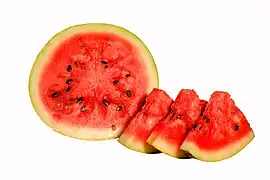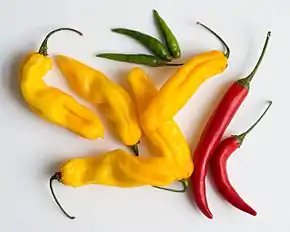辣
See also: 辢
| ||||||||
Translingual
Han character
辣 (Kangxi radical 160, 辛+7, 14 strokes, cangjie input 卜十木中 (YJDL), four-corner 05496, composition ⿰辛束)
Derived characters
- 𤁕 𣋩 𨆹 𤻬 𥶁
References
- Kangxi Dictionary: page 1251, character 12
- Dai Kanwa Jiten: character 38646
- Dae Jaweon: page 1731, character 4
- Hanyu Da Zidian (first edition): volume 6, page 4040, character 1
- Unihan data for U+8FA3
Chinese
| simp. and trad. |
辣 | |
|---|---|---|
Glyph origin
Characters in the same phonetic series (剌) (Zhengzhang, 2003)
Phono-semantic compound (形聲/形声, OC *raːd) : semantic 辛 + phonetic 束. The latter is an abbreviation of 剌 (OC *raːd).
Pronunciation
Definitions
辣
Synonyms
- (spicy):
Dialectal synonyms of 辣 (“spicy”) [map]
- (cruel):
- 兇惡/凶恶 (xiōng'è)
- 兇殘/凶残 (xiōngcán)
- 兇狠/凶狠 (xiōnghěn)
- 兇猛/凶猛 (xiōngměng)
- 兇險/凶险 (xiōngxiǎn)
- 凶暴 (xiōngbào)
- 厲害/厉害 (lìhài)
- 嚴酷/严酷 (yánkù)
- 強暴/强暴 (qiángbào)
- 忍 (rěn) (literary)
- 惡勢/恶势 (Xiamen Hokkien)
- 惡毒/恶毒 (èdú)
- 惡狠狠/恶狠狠 (èhěnhěn)
- 慘/惨 (cǎn) (literary, or in compounds)
- 暴力 (bàolì)
- 暴戾 (bàolì) (literary)
- 暴虐 (bàonüè)
- 暴躁 (bàozào)
- 殘/残 (cán) (literary,or in compounds)
- 殘忍/残忍 (cánrěn)
- 殘暴/残暴 (cánbào)
- 殘酷/残酷 (cánkù)
- 毒辣 (dúlà)
- 烏心/乌心 (Min Nan)
- 狠心 (hěnxīn)
- 狠毒 (hěndú)
- 狠狠 (hěnhěn)
- 猙獰/狰狞 (zhēngníng)
- 粗殘/粗残 (Xiamen Hokkien)
- 酷烈 (kùliè)
- 野蠻/野蛮 (yěmán)
- 陰功/阴功 (jam1 gung1) (Cantonese)
- 險惡/险恶 (xiǎn'è)
- 黑心 (hēixīn)
Compounds
- 光辣撻/光辣挞
- 吃辣麵/吃辣面
- 吃香喝辣
- 哈辣
- 大辣酥
- 心狠手辣 (xīnhěnshǒulà)
- 托辣斯
- 撲辣/扑辣
- 放屁辣臊 (fàngpìlàsāo)
- 毒辣 (dúlà)
- 清光滑辣 (qīngguānghuálà)
- 滑辣
- 潑辣/泼辣 (pōlà)
- 火焦火辣
- 火辣 (huǒlà)
- 熱辣辣/热辣辣 (rèlàlà)
- 甜不辣 (tiánbùlà)
- 甜辣醬/甜辣酱
- 甜酸苦辣 (tiánsuānkǔlà)
- 老辣 (lǎolà)
- 苦辣
- 薑桂老辣/姜桂老辣 (jiāngguìlǎolà)
- 薑越老越辣/姜越老越辣 (jiāngyuèlǎoyuèlà)
- 薑還是老的辣/姜还是老的辣 (jiāng háishì lǎo de là)
- 虎辣八
- 蹼辣
- 辛辣 (xīnlà)
- 辣乎乎
- 辣味 (làwèi)
- 辣妹 (làmèi)
- 辣子 (làzi)
- 辣實/辣实
- 辣手 (làshǒu)
- 辣拐子 (làguǎizi)
- 辣椒 (làjiāo)
- 辣氣/辣气
- 辣油 (làyóu)
- 辣浪
- 辣燥
- 辣瓣兒醬/辣瓣儿酱 (làbànrjiàng)
- 辣絲絲/辣丝丝 (làsīsī)
- 辣菜 (làcài)
- 辣菜根子
- 辣豁豁
- 辣貨/辣货
- 辣酥酥
- 辣醬/辣酱 (làjiàng)
- 辣雞/辣鸡 (làjī)
- 酸甜苦辣 (suāntiánkǔlà)
- 酸辣湯/酸辣汤 (suānlàtāng)
- 鳳辣子/凤辣子
- 麻辣 (málà)
- 黃湯辣水/黄汤辣水 (huángtānglàshuǐ)
See also
| Basic tastes in Chinese · 味道 (layout · text) | |||||
|---|---|---|---|---|---|
 |
 |
 |
 |
 |
 |
| 甜 (tián) | 酸 (suān) | 鹹/咸 (xián) | 苦 | 辣 (là) | 鮮味/鲜味 (xiānwèi) |
Etymology 2
| For pronunciation and definitions of 辣 – see 焫 (“(of hot objects) to burn; to scald; to sear; very hot; scalding”). (This character is a variant form of 焫). |
Etymology 3
| For pronunciation and definitions of 辣 – see 垃 (“to be at; to be located at; etc.”). (This character is a variant form of 垃). |
References
- “辣”, in 漢語多功能字庫 (Multi-function Chinese Character Database), 香港中文大學 (the Chinese University of Hong Kong), 2014–
Japanese
Kanji
辣
- This term needs a translation to English. Please help out and add a translation, then remove the text
{{rfdef}}.
Readings
Korean
Hanja
辣 (eumhun 매울 랄 (mae'ul ral), South Korea 매울 날 (mae'ul nal))
- This term needs a translation to English. Please help out and add a translation, then remove the text
{{rfdef}}.
Vietnamese
Han character
辣: Hán Việt readings: lạt[1][2][3]
辣: Nôm readings: lượt, lát[2], lướt[2], nhạt[2], nhợt[2]
References
- Trần (1999).
- Hồ (1976).
- Génibrel (1898).
This article is issued from Wiktionary. The text is licensed under Creative Commons - Attribution - Sharealike. Additional terms may apply for the media files.